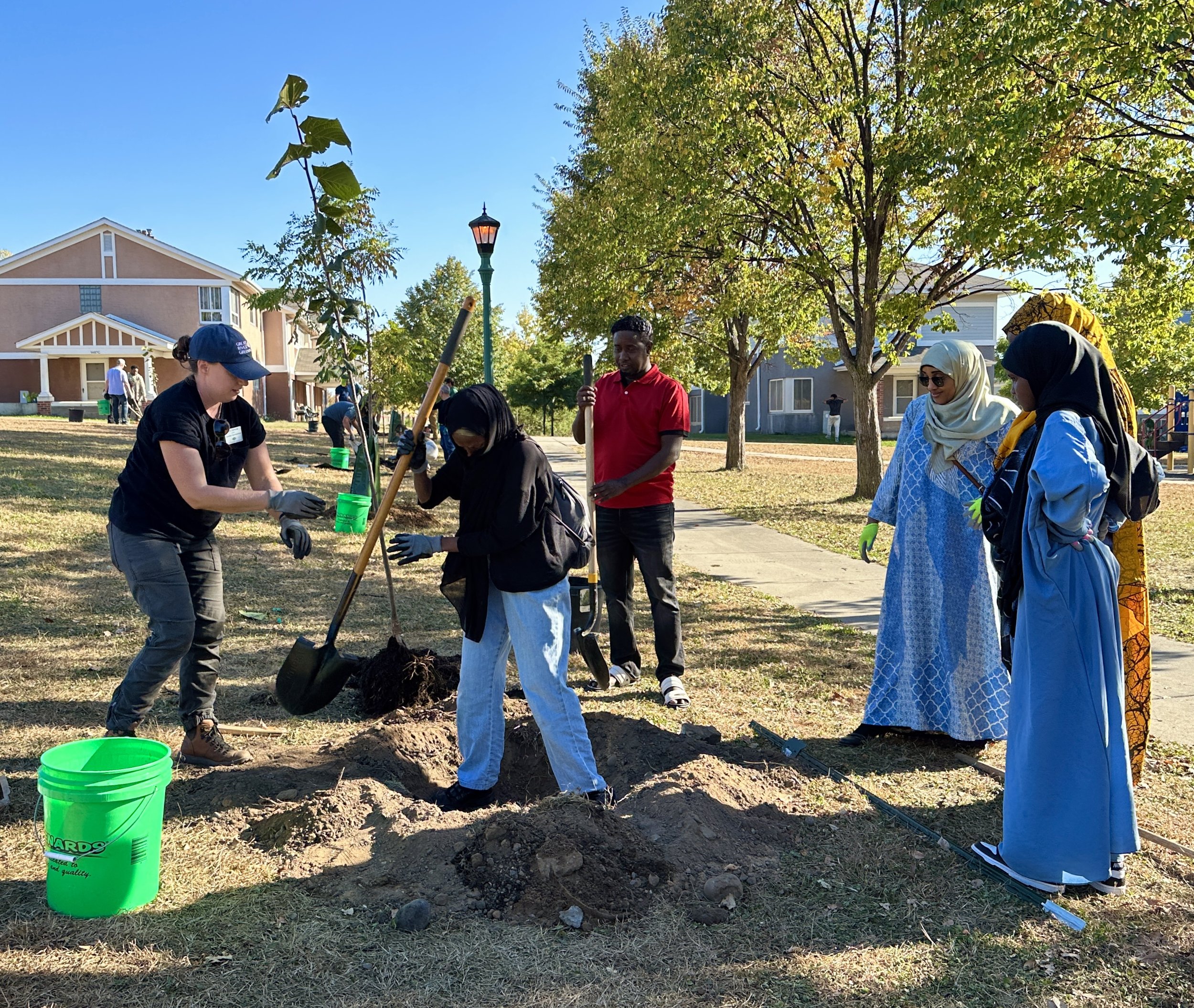Celebrating and Honoring Black Environmentalists: Planting Trees, Building Communities
2/4/2025
In celebration of Black History Month, Great River Greening is proud to honor the legacy of black environmentalists and celebrate the efforts of current community leaders who are advocating for more trees in their communities. Today, we are excited to highlight Hattie Carthan and Mazel “May” McCoy-Anderson, two women whose work represents the past and future of environmental stewardship and community–driven change.
Hattie "The Tree Lady of Brooklyn" Carthan
Hattie Carthan (September 7, 1900 – April 22, 1984)
Hattie Carthan, known as “The Lady of Brooklyn,” is remembered for her tireless work to revitalize her community through the simple but powerful act of planting trees. Hattie moved to Brooklyn in 1928 and later settled on the picturesque, tree-lined streets of Bedford-Stuyvesant, specifically Vernon Avenue, in 1953. Over the years, the neighborhood faced growing poverty, neglect, and racial injustices, including the Harlem Race Riots of 1964. By that year, only four trees remained on Vernon Avenue.
Years of hardship had taken a toll on the community, but Hattie’s response was simple: plant trees. Her efforts were more than about beautification—they were about reclamation. In a time when the community was hurting, planting trees became a way to reclaim the streets and renew the sense of community. When asked if she ever considered moving away as the neighborhood’s struggles worsened, Hattie responded:
“We’ve already lost too many trees, houses, and people…your community—you owe something to it. I didn’t care to run.”
In 1967, she formed the Bedford-Stuyvesant Beautification Committee with the goal of planting trees. Over the next decade, the committee planted more than 1,500 trees—ginkos, sycamores, honey locusts, and others well suited to Brooklyn’s urban climate.
Hattie’s vision continues to resonate today, as we continue to face challenges like climate change and urban heat islands—issues that disproportionately affect communities of color. Her legacy not only reminds us of the power of trees to provide shade and clean air, but also to unite communities around shared solutions. Hattie’s vision continues to resonate today, as we continue to face challenges like climate change and urban heat islands—issues that disproportionately affect communities of color. Her legacy not only reminds us of the power of trees to provide shade and clean air, but also to unite communities around shared solutions.
Cooling Minnesota Communities
At Great River Greening, we carry forward the spirit of Hattie’s work through programs like our Cooling Minnesota Communities. This program was built on community conversations with residents directly impacted by heat islands sharing their input on how to address the issue. Together, we have created a comprehensive program focused on planting, distributing, and watering trees in neighborhoods across Minnesota affected by heat islands and inadequate tree canopy coverage. By strategically planting trees with community input, we’re improving air and water quality, providing shade, and reducing temperatures in heat islands areas—all while strengthening community resilience.
Mazel “May” McCoy-Anderson: Advocate for Environmental Change in Black Communities
Mazel "May” McCoy-Anderson became an advocate for tree planting and environmental change after a deeply impactful experience. One Sunday, as she walked out of her church—Camphor Memorial United Methodist Church on Fuller Avenue in St. Paul—she was alarmed to notice that all the trees around the church had been removed.
The once-shaded area was now exposed to the harsh sun, with no relief in sight. Stunned, May asked herself, what happened to the trees?
In that moment, May realized a critical truth: without trees, there’s no shade or natural protection from the elements. It wasn’t just about losing the trees—it was about the impact on her community’s well-being
Determined to make a change, May heard about the Great River Greening’s Cool St. Paul tree-planting program and immediately volunteered. Through her involvement, she played a a key role in shaping the tree-planting program during its pilot phase by providing invaluable input through community input sessions.
Great River Greening’s tree planting at Camphor Memorial United Church, September 2024.
“Camphor has been here over 100 years, and I want to see us here 100 more, with trees preserved and cared for our kids.”
— May McCoy-Anderson
Her advocacy ensured that trees were planted where they were needed most — including Camphor Memorial United Methodist Church in Saint Paul, an area severely lacking a healthy tree canopy. Last fall, sixteen climate-resilient shade trees were planted, including bur oak, disease-resistant elm, common hackberry, ironwood, and honey locust. They will be watered and cared for by the Great River Greening crew for the next three years.
Community leaders like May continue to lead the way in advocating for environmental justice and equitable solutions within black communities. May continues to lead that charge as a dedicated volunteer with Great River Greening and a passionate community advocate.
A Legacy and a Vision
The stories of Hattie and May remind us that meaningful change begins with individuals who care deeply about their communities. As we look back on Hattie’s transformative work and celebrate May’s ongoing contributions, we are inspired to continue the mission of building greener, healthier, and more equitable communities.
Join the Movement
You, too, can make a difference. Volunteer to plant and distribute trees through our Cooling Minnesota Communities program, which offers volunteer opportunities throughout the spring and fall. Check our calendar for events - All are welcome.
Together, we can create lasting change.





